

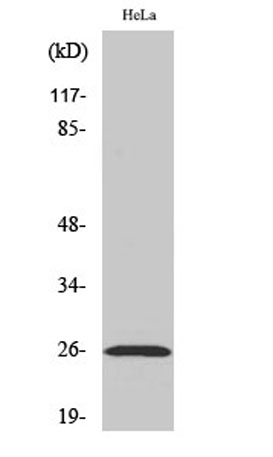
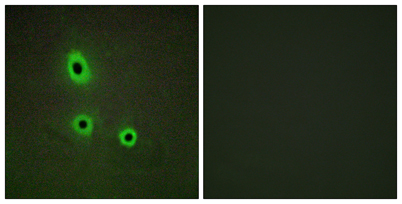
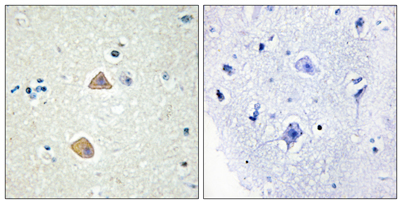
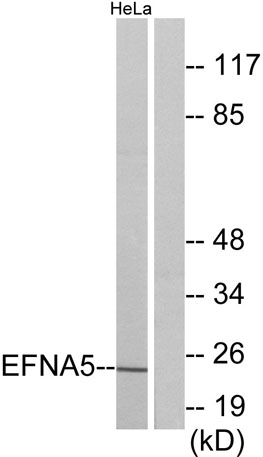
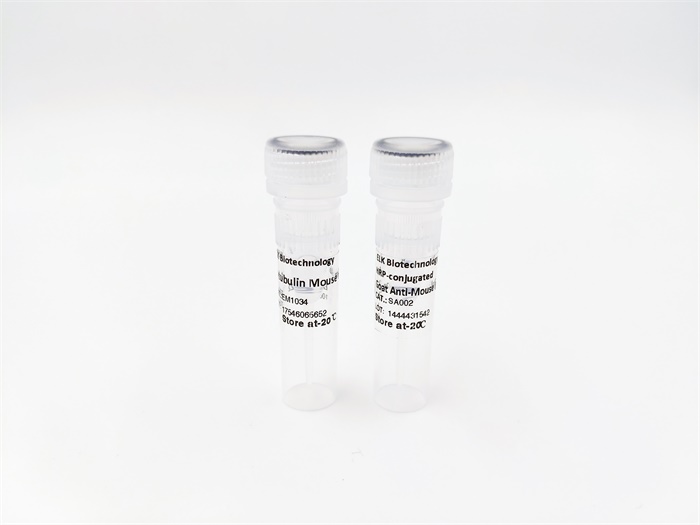



Ephrin-A5 rabbit pAb
 One-click to copy product information
One-click to copy product information$148.00/50µL $248.00/100µL
| 50 µL | $148.00 |
| 100 µL | $248.00 |
Overview
| Product name: | Ephrin-A5 rabbit pAb |
| Reactivity: | Human;Mouse;Rat |
| Alternative Names: | EFNA5; EPLG7; LERK7; Ephrin-A5; AL-1; EPH-related receptor tyrosine kinase ligand 7; LERK-7 |
| Source: | Rabbit |
| Dilutions: | Western Blot: 1/500 - 1/2000. Immunohistochemistry: 1/100 - 1/300. Immunofluorescence: 1/200 - 1/1000. ELISA: 1/40000. Not yet tested in other applications. |
| Immunogen: | The antiserum was produced against synthesized peptide derived from human EFNA5. AA range:31-80 |
| Storage: | -20°C/1 year |
| Clonality: | Polyclonal |
| Isotype: | IgG |
| Concentration: | 1 mg/ml |
| Observed Band: | 25kD |
| GeneID: | 1946 |
| Human Swiss-Prot No: | P52803 |
| Cellular localization: | Cell membrane ; Lipid-anchor, GPI-anchor . Membrane, caveola ; Lipid-anchor, GPI-anchor . Compartmentalized in discrete caveolae-like membrane microdomains. |
| Background: | Ephrin-A5, a member of the ephrin gene family, prevents axon bundling in cocultures of cortical neurons with astrocytes, a model of late stage nervous system development and differentiation. The EPH and EPH-related receptors comprise the largest subfamily of receptor protein-tyrosine kinases and have been implicated in mediating developmental events, particularly in the nervous system. EPH receptors typically have a single kinase domain and an extracellular region containing a Cys-rich domain and 2 fibronectin type III repeats. The ephrin ligands and receptors have been named by the Eph Nomenclature Committee (1997). Based on their structures and sequence relationships, ephrins are divided into the ephrin-A (EFNA) class, which are anchored to the membrane by a glycosylphosphatidylinositol linkage, and the ephrin-B (EFNB) class, which are transmembrane proteins. The Eph family of receptors are similarly divi |
-
 Western Blot analysis of various cells using Ephrin-A5 Polyclonal Antibody
Western Blot analysis of various cells using Ephrin-A5 Polyclonal Antibody -
 Immunofluorescence analysis of A549 cells, using EFNA5 Antibody. The picture on the right is blocked with the synthesized peptide.
Immunofluorescence analysis of A549 cells, using EFNA5 Antibody. The picture on the right is blocked with the synthesized peptide. -
 Immunohistochemistry analysis of paraffin-embedded human brain tissue, using EFNA5 Antibody. The picture on the right is blocked with the synthesized peptide.
Immunohistochemistry analysis of paraffin-embedded human brain tissue, using EFNA5 Antibody. The picture on the right is blocked with the synthesized peptide. -
 Western blot analysis of lysates from HeLa cells, using EFNA5 Antibody. The lane on the right is blocked with the synthesized peptide.
Western blot analysis of lysates from HeLa cells, using EFNA5 Antibody. The lane on the right is blocked with the synthesized peptide.

 Manual
Manual